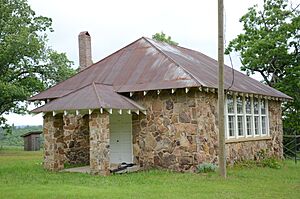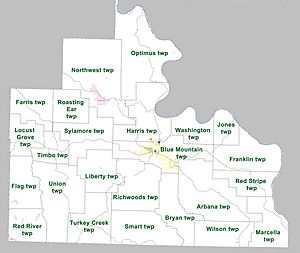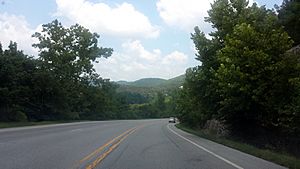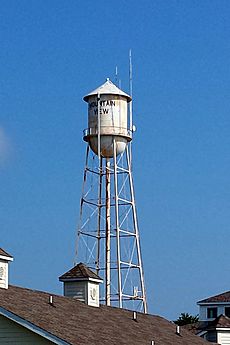Stone County, Arkansas facts for kids
Quick facts for kids
Stone County
|
|
|---|---|
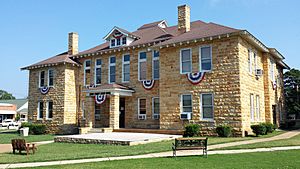
Stone County courthouse in Mountain View
|
|
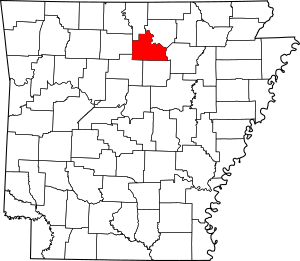
Location within the U.S. state of Arkansas
|
|
 Arkansas's location within the U.S. |
|
| Country | |
| State | |
| Founded | April 21, 1873 |
| Named for | rock formations in the area |
| Seat | Mountain View |
| Largest city | Mountain View |
| Area | |
| • Total | 609.43 sq mi (1,578.4 km2) |
| • Land | 606.59 sq mi (1,571.1 km2) |
| • Water | 2.84 sq mi (7.4 km2) 0.5%% |
| Population
(2020)
|
|
| • Total | 12,359 |
| • Density | 20.2796/sq mi (7.8300/km2) |
| Time zone | UTC−6 (Central) |
| • Summer (DST) | UTC−5 (CDT) |
| Congressional district | 1st |
Stone County is located in the Ozark Mountains in the U.S. state of Arkansas. The county is named for the rugged, rocky area terrain of the Ozarks. Created as Arkansas's 74th county on April 21, 1873, Stone County has two incorporated cities: Mountain View, the county seat and most populous city, and Fifty-Six. The county is also the site of numerous unincorporated communities and ghost towns.
Most of the county is sparsely populated forested Ozark hills; including the northern fifth of the county managed by the United States Forest Service as the Ozark National Forest. The remainder of the county is used for poultry, ranching, and timber production. The White River runs along the eastern boundary of Stone County. The county contains six protected areas in addition to the Ozark National Forest: Blanchard Springs Caverns within the Ozark National Forest, two Natural Areas, two Wildlife Management Areas and the Ozark Folk Center, which preserves and interprets Ozark cultural heritage, especially traditional mountain folk music and crafts. Other features such as log cabins, one-room school houses, community centers, and museums, as well as annual cultural events, preserve the history and culture of Stone County.
Stone County occupies 609.43 square miles (1,578.4 km2) and contained a population of 12,359 as of the 2020 Census.
Contents
Geography
Stone County is located in the Ozark Mountains, one of the six ecoregions of Arkansas. The Ozarks are a mountainous subdivision of the U.S. Interior Highlands, and Stone County contains the Springfield Plateau, Salem Plateau, and the relatively steeper Boston Mountains subsets. The county is roughly split along an east–west line near Mountain View, the centrally located county seat, with areas north within the Springfield Plateau, and areas south within the Boston Mountains. Areas along the White River, which forms the county's northeastern boundary, are dissected bluffs of the Salem Plateau rather than riparian floodplains. According to the U.S. Census Bureau, the county has a total area of 609.43 square miles (1,578.4 km2), of which 606.59 square miles (1,571.1 km2) is land and 2.84 square miles (7.4 km2) (0.5%) is water.
The county is located approximately 105 miles (169 km) north of Little Rock, 151 miles (243 km) northwest of Memphis, Tennessee, and 278 miles (447 km) southwest of St. Louis, Missouri. Stone County is surrounded by three Ozark counties, Searcy County to the west, Baxter County to the northwest, Izard County to the northeast, and three border counties with the Arkansas River Valley, Van Buren County to the southwest, Cleburne County to the south, and Independence County (which also contains a small piece of the Arkansas Delta) to the east.
Hydrology
National protected area
- Ozark National Forest (part)
Demographics
| Historical population | |||
|---|---|---|---|
| Census | Pop. | %± | |
| 1880 | 5,089 | — | |
| 1890 | 7,043 | 38.4% | |
| 1900 | 8,100 | 15.0% | |
| 1910 | 8,946 | 10.4% | |
| 1920 | 8,779 | −1.9% | |
| 1930 | 7,993 | −9.0% | |
| 1940 | 8,603 | 7.6% | |
| 1950 | 7,662 | −10.9% | |
| 1960 | 6,294 | −17.9% | |
| 1970 | 6,838 | 8.6% | |
| 1980 | 9,022 | 31.9% | |
| 1990 | 9,775 | 8.3% | |
| 2000 | 11,499 | 17.6% | |
| 2010 | 12,394 | 7.8% | |
| 2020 | 12,359 | −0.3% | |
| 2023 (est.) | 12,671 | 2.2% | |
| U.S. Decennial Census 1790–1960 1900–1990 1990–2000 2010 |
|||
2020 Census
| Race | Number | Percentage |
|---|---|---|
| White (non-Hispanic) | 11,387 | 92.14% |
| Black or African American (non-Hispanic) | 21 | 0.17% |
| Native American | 87 | 0.7% |
| Asian | 25 | 0.2% |
| Pacific Islander | 2 | 0.02% |
| Other/Mixed | 566 | 4.58% |
| Hispanic or Latino | 271 | 2.19% |
As of the 2020 United States census, there were 12,359 people, 4,787 households, and 3,109 families residing in the county.
2010 Census
As of the 2010 census, there were 12,394 people, 5,325 households, and 3,590 families residing in the county. The population density was 20 people per square mile (7.7 people/km2). There were 6,712 housing units at an average density of 11 units per square mile (4.2 units/km2). The racial makeup of the county was 96.8% White, 0.1% Black or African American, 0.7% Native American, 0.4% Asian, 0.0% Pacific Islander, 0.4% from other races, and 1.6% from two or more races. 1.3% of the population were Hispanic or Latino of any race.
There were 5,325 households, out of which 26.0% had children under the age of 18 living with them, 67.4% were married couples living together, 7.2% had a female householder with no husband present, and 32.6% were non-families. 28.9% of all households were made up of individuals, and 36.6% had someone living alone who was 65 years of age or older. The average household size was 2.30 and the average family size was 2.81.
In the county, the population was spread out, with 20.6% under the age of 18, 6.2% from 18 to 24, 19.4% from 25 to 44, 31.0% from 45 to 64, and 22.8% who were 65 years of age or older. The median age was 37.2 years. For every 100 females there were 97.8 males. For every 100 females age 18 and over, there were 96.2 males.
The median income for a household in the county was $30,380, and the median income for a family was $36,765. Males had a median income of $28,258 versus $25,341 for females. The per capita income for the county was $16,090. About 16.6% of families and 23.4% of the population were below the poverty line, including 35.7% of those under age 18 and 20.6% of those age 65 or over.
Culture and contemporary life
Media
The county newspaper is the Stone County Leader, a weekly published in Mountain View since 1952. Former newspapers include the Stone County Democrat and Mountain View Herald (1932-1953). Mountain View has also produced several short-lived publications, including the Mountain View News (1905-1906), The Mountain View (1973-1974), and The Ozark Times (1906-1913).
The Stone County Historical Society has published the Heritage of Stone since 1972. Issued twice annually to members and available to the public for individual purchase, the publication covers topics relating to the history and culture of Stone County.
Communities
Two incorporated cities are located within the county. The largest city and county seat, Mountain View, is relatively centrally located in the oddly-shaped county. Mountain View's population in 2010 was 2,748, marking the first decennial decline since the 1960 Census. Fifty-Six has maintained a stable population under 200 since incorporation.
Stone County has dozens of unincorporated communities and ghost towns within its borders. This is due to early settlers in Arkansas tending to settle in small clusters rather than incorporated towns. For example, communities like Newnata had a post office and dozens of buildings at some point in their history. Other communities are simply a few dwellings at a crossroads that have adopted a common place name over time. Some are officially listed as populated places by the United States Geological Survey, and others are listed as historic settlements.
Cities
- Fifty-Six
- Mountain View (county seat)
Unincorporated communities
- Alco
- Allison
- Arlberg
- Ben
- Big Springs
- Chalybeate Springs
- East Richwoods
- Flag
- Fox
- Gayler
- Hanover
- Harness
- Herpel
- Luber
- Lydalisk
- Marcella
- Meadow Creek
- Melrose
- Mozart
- Newnata
- Old Lexington
- Onia
- Optimus
- Parma
- Pleasant Grove
- Pleasant Hill
- Rushing
- St. James
- Timbo
- Turkey Creek
- West Richwoods
Historical communities
- Bluetip
- Bothersome
- Boyle
- Buckhorn
- Hedges
- Kahoka
- May
- Oga
- Pekin
- Red Stripe
Townships
Townships in Arkansas are the divisions of a county. Each township includes unincorporated areas; some may have incorporated cities or towns within part of their boundaries. Arkansas townships have limited purposes in modern times. However, the United States Census does list Arkansas population based on townships (sometimes referred to as "county subdivisions" or "minor civil divisions"). Townships are also of value for historical purposes in terms of genealogical research. Each town or city is within one or more townships in an Arkansas county based on census maps and publications. The townships of Stone County are listed below; listed in parentheses are the cities, towns, and/or census-designated places that are fully or partially inside the township.
- Arbana (small part of Mountain View)
- Blue Mountain (most of Mountain View)
- Bryan
- Farris
- Flag
- Franklin
- Harris (small part of Mountain View)
- Jones
- Liberty
- Locust Grove
- Marcella
- Northwest (Fifty-Six)
- Optimus
- Red River
- Red Stripe
- Richwoods
- Roasting Ear
- Smart
- Sylamore
- Timbo
- Turkey Creek
- Union
- Washington
- Wilson
Infrastructure
Aviation
Mountain View Airport is the only public owned/public use airport in Stone County. Also known as Harry E. Wilcox Memorial Field, the facility is a small, rural general aviation airport with 5,650 annual operations. Stone County also contains one private airfield. The nearest commercial service airport is Clinton National Airport in Little Rock.
Major highways
Stone County is not served by any Interstate highways nor United States highways; the nearest access to the Interstate system is Interstate 40 (I-40) in Conway. Ten state highways serve the traveling public in the county, varying from short connector routes to long highways traversing the entire county. Highway 5 and Highway 9 are major north–south highways across the Ozarks; each crosses through the county through Mountain View. The two routes briefly form a concurrency, or overlap, between Mountain View and Allison.
Highway 14 is a major east–west highway across northern Arkansas, it crosses the county and connects Mountain View and Fifty-Six via an overlap with Highway 5 and Highway 9. Highway 87 connects the communities more directly along a winding alignment. Highway 66 has its eastern terminus in Mountain View, and runs west to Leslie in Searcy County, connecting Mountain View to US Highway 65 (US 65). Highway 263 connects several unincorporated communities in southwestern Stone County. Highway 382 serves as an access for Ozark Folk Center State Park. Highway 58, Highway 74, and Highway 110 pass through the county for a few miles on their way to other destinations.
The county also contains the Sylamore Scenic Byway, an Arkansas Scenic Byway and National Forest Scenic Byway.
Utilities
Entergy Arkansas is the sole provider of electricity in almost all of Stone County, with exceptions in the northern tip (served by North Arkansas Electric Cooperative), south of Mountain View (First Electric Cooperative) and the southwest corner (Petit Jean Electric Cooperative).
The Arkansas Department of Health (ADH) is responsible for the regulation and oversight of public water systems throughout the state. Stone County contains six community water systems: the City of Fifty-Six Water Department, the City of Mountain View Water Department, Pleasant Grove Water Association, Richwoods Water Association, Sylamore Valley Water Association, and the West Stone County Water Association. Mountain View has the largest direct retail population served (7,295, all in Stone County), followed by West Stone County (4,634, including customers served in adjacent counties), Pleasant Grove Water Association (2,315), and Richwoods Water Association (1,436), with the remaining systems under 600 retail population served. Of the water systems serving Stone County, only Fifty-Six uses groundwater, the Gunter Sandstone Aquifer, though also purchasing water from Big Flat, which pumps from the same aquifer. The City of Mountain View uses the White River, and the remaining systems purchasing treated water from Mountain View.
See also
 In Spanish: Condado de Stone (Arkansas) para niños
In Spanish: Condado de Stone (Arkansas) para niños


